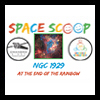CXC Home | Search | Help | Image Use Policy | Latest Images | Privacy | Accessibility | Glossary | Q&A
Tour of NGC 1929
Quicktime MPEG
The star cluster known as NGC 1929 is embedded in a cloud of gas and dust, which astronomers call the N44 nebula. Many new stars, some of them very massive, are forming within this star cluster. These massive stars produce intense radiation, expel matter at high speeds, and race through their evolution to explode as supernovas. The winds and supernova shock waves carve out huge cavities called superbubbles in the surrounding gas. X-rays from NASA's Chandra X-ray Observatory show hot regions created by these winds and shocks. Meanwhile, infrared data from NASA's Spitzer Space Telescope outline where the dust and cooler gas are found. An optical light image from a European Space Observatory telescope in Chile shows where ultraviolet radiation from hot, young stars is causing gas in the nebula to glow.
[Runtime: 01:04]
Quicktime MPEG
The star cluster known as NGC 1929 is embedded in a cloud of gas and dust, which astronomers call the N44 nebula. Many new stars, some of them very massive, are forming within this star cluster. These massive stars produce intense radiation, expel matter at high speeds, and race through their evolution to explode as supernovas. The winds and supernova shock waves carve out huge cavities called superbubbles in the surrounding gas. X-rays from NASA's Chandra X-ray Observatory show hot regions created by these winds and shocks. Meanwhile, infrared data from NASA's Spitzer Space Telescope outline where the dust and cooler gas are found. An optical light image from a European Space Observatory telescope in Chile shows where ultraviolet radiation from hot, young stars is causing gas in the nebula to glow.
[Runtime: 01:04]
(Credit: NASA/CXC/A. Hobart)
At the End of the Rainbow
Quicktime MPEG
Looking up at the night sky, you might think that space is dull, with lots of black, some white dots and just a hint of red if you're lucky. But if we look deeper, space has a lot more to offer than what our eyes can see!
You've probably heard the phrase 'visible light'. This is what we call the range of colors that humans can see with their eyes. Visible light is just a tiny portion of all light. So astronomers have built special telescopes to see things that human eyes can't! For this picture, three telescopes were used and each picked up a different type of light.
This image shows a 'superbubble', a cloud of hot gas blown away from bright, young stars at its center. The superbubble has been captured with one of the telescopes in X-ray light, which has been colored blue. X-rays have a lot of energy, so when we look at the Universe in X-ray light, we see some of the hottest gas and most powerful explosions.
Infrared light is given off by much cooler objects than stars. For example, humans give off infrared light of our own! In this picture, infrared shows us the colder gas and dust of the superbubble, colored in red. This part of the picture was taken with the second telescope. The rest of the picture is yellow, showing us visible light. These are the parts of the image that we could see with our own eyes, if we were close enough, and if our eyes were sensitive enough!
[Runtime: 02:14]
Quicktime MPEG
Looking up at the night sky, you might think that space is dull, with lots of black, some white dots and just a hint of red if you're lucky. But if we look deeper, space has a lot more to offer than what our eyes can see!
You've probably heard the phrase 'visible light'. This is what we call the range of colors that humans can see with their eyes. Visible light is just a tiny portion of all light. So astronomers have built special telescopes to see things that human eyes can't! For this picture, three telescopes were used and each picked up a different type of light.
This image shows a 'superbubble', a cloud of hot gas blown away from bright, young stars at its center. The superbubble has been captured with one of the telescopes in X-ray light, which has been colored blue. X-rays have a lot of energy, so when we look at the Universe in X-ray light, we see some of the hottest gas and most powerful explosions.
Infrared light is given off by much cooler objects than stars. For example, humans give off infrared light of our own! In this picture, infrared shows us the colder gas and dust of the superbubble, colored in red. This part of the picture was taken with the second telescope. The rest of the picture is yellow, showing us visible light. These are the parts of the image that we could see with our own eyes, if we were close enough, and if our eyes were sensitive enough!
[Runtime: 02:14]
(Credit: NASA/CXC/April Jubett)
Return to NGC 1929 (August 30, 2012)




